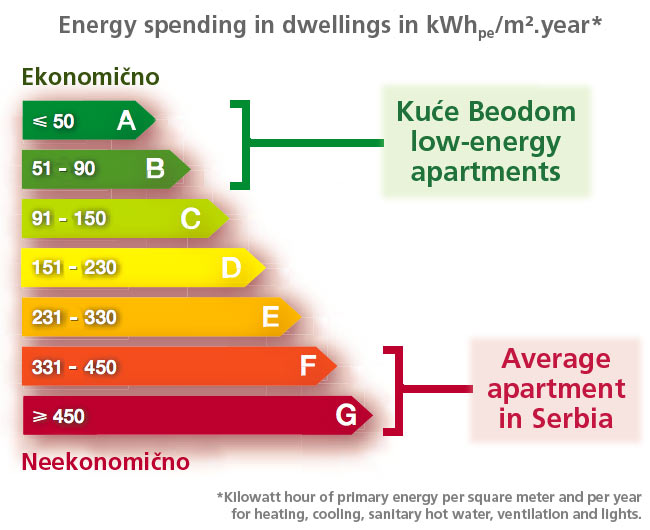Low-energy
Low-energy means spending little energy for providing heating, cooling and sanitary hot water in one apartment. It means building energy efficient apartments, and using free renewable energy to further reduce the energy cost. It means spending 4 to 5 times less money for much better comfort.

Energy rating of Beodom apartments compared to average Serbian ones.
Low-energy and primary energy
Low-energy refers to the amount of primary energy needed in a dwelling for heating, cooling, sanitary hot water, ventilation and lights. That amount of primary energy must be below a given threshold for the dwelling to claim the low-energy label. Primary energy spent in a dwelling is expressed in Kilowatt-hour of primary energy per square meter per year (kWhpe⁄m².year).
Primary energy represents raw energy before transformation, such as the energy contained in fossil fuels.
Electricity and primary energy
Electricity is a secondary energy. To produce electricity, primary energy has to be used, such as burning coal, burning natural gas, using nuclear energy, using hydro-power or using photovoltaic solar panels.
Because of the losses during production and transport of electricity, a factor has to be applied to convert electric energy to primary energy. That factor vary from 2 to 3 depending the way electricity is produced in one country. In Serbia, where electricity is mainly produced using poor quality coal, the factor should be close to 3. If we take 2.7, it means that using 1 kWh of electricity consumes 2.7 kWhpe.
Energy rating of Beodom constructions
There are different norms defining the threshold of primary energy consumption for claiming the low-energy label (Minergie in Switzerland, Effinergie in France, Passivhaus in Germany or CasaClima in Italy). There is nothing yet in Serbia. In France, with the norm Effinergie, claiming low-energy means using, depending of the climatic zone, less than 40 to less than 65 kWhpe⁄m².year.
Beodom is committed to build apartments in class A or B, spending less than 90 kWhpe⁄m².year.
To achieve such a low-energy spending, Beodom works on improving energy efficiency and on using renewable energy to replace the use of energy derived from fossil fuels.
Today standards in Serbia
In Serbia, good norms and standards are not yet established. Mostly, builders don't do better than the current Serbian norm. That is using few centimeters of thermal insulation, regular windows, taking no care about thermal bridges and using only electricity or fossil fuels to heat and cool the dwellings. Such dwellings are in class F or G. That is using more than 330 kWhpe⁄m².year for heating, cooling and hot water.



 Low-energy requirement
Low-energy requirement
























